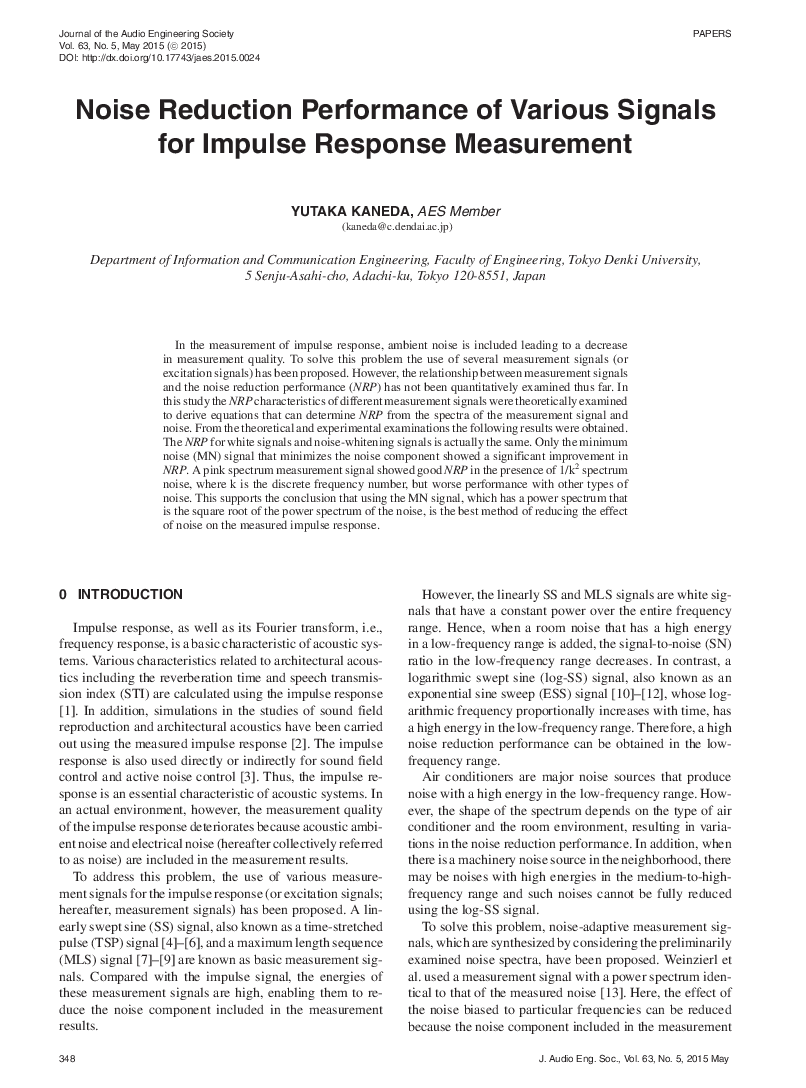Home / Publications / E-library page
You are currently logged in as an
Institutional Subscriber.
If you would like to logout,
please click on the button below.
Home / Publications / E-library page
Only AES members and Institutional Journal Subscribers can download
When measuring the acoustic impulse response in a real environment, acoustic and electrical noise corrupts the result. To improve the quality of measurements, researchers often use various excitation measurement signals, such as a linearly swept sine (SS) wave or a maximum length sequence (MLS) signal because they have high energy at all frequencies. But when the noise is dominated by low-frequency components, the S/N in this region is reduced. In this study, the noise reduction performance (NRP) of different excitation signals was theoretically examined to derive equations that can determine the NRP from the spectra of the measurement signal and noise. From the theoretical and experimental examinations, the following results were obtained. The NPR for white signals and noise-whitening signals is actually the same. Only the minimum noise (MN) signal that minimizes the noise component showed a significant improvement in NPR. A pink spectrum measurement signal showed good NPR in the presence of 1/k2 spectrum noise, where k is the discrete frequency number, but worse performance with other types of noise. This supports the conclusion that using the MN signal, which has a power spectrum that is the square root of the power spectrum of the noise, is the best method of reducing the effect of noise on the measured impulse response.
Author (s): Kaneda, Yutaka
Affiliation:
Department of Information and Communication Engineering, Faculty of Engineering, Tokyo Denki University, Adachi-ku, Tokyo, Japan
(See document for exact affiliation information.)
Publication Date:
2015-05-06
Import into BibTeX
Permalink: https://aes2.org/publications/elibrary-page/?id=17640
(497KB)
Click to purchase paper as a non-member or login as an AES member. If your company or school subscribes to the E-Library then switch to the institutional version. If you are not an AES member Join the AES. If you need to check your member status, login to the Member Portal.

Kaneda, Yutaka; 2015; Noise Reduction Performance of Various Signals for Impulse Response Measurement [PDF]; Department of Information and Communication Engineering, Faculty of Engineering, Tokyo Denki University, Adachi-ku, Tokyo, Japan; Paper ; Available from: https://aes2.org/publications/elibrary-page/?id=17640
Kaneda, Yutaka; Noise Reduction Performance of Various Signals for Impulse Response Measurement [PDF]; Department of Information and Communication Engineering, Faculty of Engineering, Tokyo Denki University, Adachi-ku, Tokyo, Japan; Paper ; 2015 Available: https://aes2.org/publications/elibrary-page/?id=17640